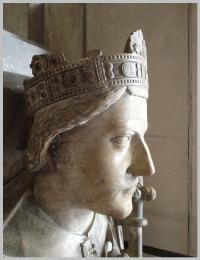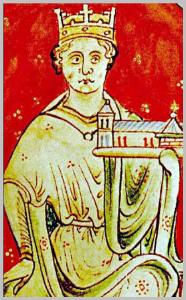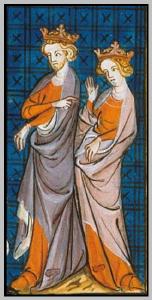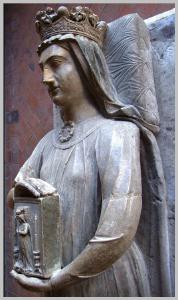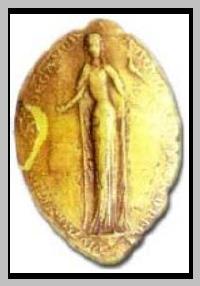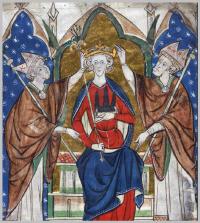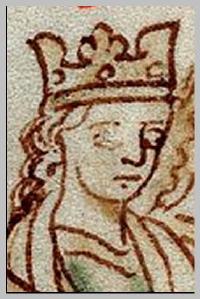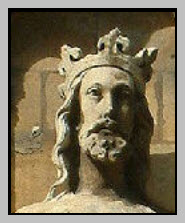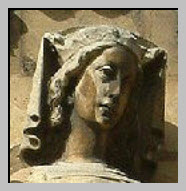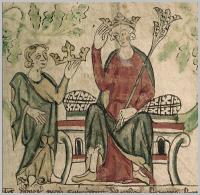Matilda (?) Duchess of Saxony and Bavaria1
F, b. June 1156, d. 13 July 1189
| Birth* | June 1156 | Matilda (?) Duchess of Saxony and Bavaria was born in June 1156.1 |
| Death* | 13 July 1189 | She died on 13 July 1189 at age 33.1 |
Richard I (?)1
M, b. 8 September 1157, d. 6 April 1199
| Birth* | 8 September 1157 | Richard I (?) was born on 8 September 1157 at Beaumont Palace, Oxford.1,2 |
| Marriage* | 12 May 1191 | He married Berengaria (?) of Navarre on 12 May 1191; No legitimate issue. Probably a homosexual.3,4 |
| Death* | 6 April 1199 | Richard I (?) died on 6 April 1199 at Châlus-Chabro, Limousin, at age 41; Richard died on 6 April 1199 in the arms of his mother, and thus "ended his earthly day".[118] Because of the nature of Richard's death, it was later referred to as "the Lion by the Ant was slain".[119] According to one chronicler, Richard's last act of chivalry proved fruitless when the infamous mercenary captain Mercadier had the crossbowman flayed alive and hanged as soon as Richard died.[120]2 |
| Burial* | | He was buried at Fontevraud.4 |
| Name-Variation | | Richard I (?) was also known as Richard the Lion hearted.1 |
| Reign* | between 1189 and 1199 | He reigned between between 1189 and 1199.4 |
| Coronation* | 1189 | He was coronated in 1189 at (?) Westminster.4 |
| Note* | 25 March 1199 | Richard I (?) In the early evening of 25 March 1199, Richard was walking around the castle perimeter without his chainmail, investigating the progress of sappers on the castle walls. Missiles were occasionally shot from the castle walls, but these were given little attention. One defender, in particular, amused the king greatly—a man standing on the walls, crossbow in one hand, the other clutching a frying pan he had been using all day as a shield to beat off missiles. He deliberately aimed at the king, which the king applauded; however, another crossbowman then struck the king in the left shoulder near the neck. He tried to pull this out in the privacy of his tent but failed; a surgeon called a "butcher" by Howden, removed it, "carelessly mangling" the King's arm in the process.
The wound swiftly became gangrenous. Richard asked to have the crossbowman brought before him; called alternatively Pierre (or Peter) Basile, John Sabroz, Dudo,[115][116] and Bertrand de Gourdon (from the town of Gourdon) by chroniclers, the man turned out (according to some sources, but not all) to be a boy. He said Richard had killed his father and two brothers, and that he had killed Richard in revenge. He expected to be executed, but as a final act of mercy Richard forgave him, saying "Live on, and by my bounty behold the light of day", before he ordered the boy to be freed and sent away with 100 shillings.[117] It is unclear whether the King's pardon was upheld following his death. Richard then set his affairs in order, bequeathing all his territory to his brother John and his jewels to his nephew Otto. on 25 March 1199 at Châlus-Chabrol., Limousin.2 |
Geoffrey II, Duke of Brittany Geoffrey (?)1
M, b. 23 September 1158, d. 19 August 1186
| Birth* | 23 September 1158 | Geoffrey II, Duke of Brittany Geoffrey (?) was born on 23 September 1158.1 |
| Death* | 19 August 1186 | He died on 19 August 1186 at age 27.1 |
Eleanor, queen of Castile Eleanor (?)1
F, b. 13 October 1162, d. 13 October 1214
| Birth* | 13 October 1162 | Eleanor, queen of Castile Eleanor (?) was born on 13 October 1162.1 |
| Death* | 13 October 1214 | She died on 13 October 1214 at age 52.1 |
Joan (?) queen of Sicily1
F, b. October 1165, d. 4 September 1199
| Birth* | October 1165 | Joan (?) queen of Sicily was born in October 1165.1 |
| Death* | 4 September 1199 | She died on 4 September 1199 at age 33.1 |
John, King of England (?)1
M, b. 27 December 1166, d. 19 October 1216
| Birth* | 27 December 1166 | John, King of England (?) was born on 27 December 1166.1 |
| Marriage* | 29 August 1189 | He married Isabella (?) Countess of Gloucester on 29 August 1189 at Marlborough Castle, Wiltshire.2 |
| Marriage* | 24 August 1200 | John, King of England (?) married Isabella (?) of Angoulême on 24 August 1200.3 |
| Death* | 19 October 1216 | John, King of England (?) died on 19 October 1216 at age 49.1 |
| Burial* | | He was buried at Worcester.4 |
| Note | | He John (24 December 1166 – 19 October 1216), also known as John Lackland (Norman French: Johan sanz Terre),[1] was King of England from 1199 until his death in 1216. John lost the Duchy of Normandy to King Philip II of France, resulting in the collapse of most of the Angevin Empire and contributing to the subsequent growth in power of the Capetian dynasty during the 13th century. The baronial revolt at the end of John's reign led to the sealing of Magna Carta, a document sometimes considered an early step in the evolution of the constitution of the United Kingdom.5 |
| Note | | He John (24 December 1166 – 19 October 1216), also known as John Lackland,[1] was King of England from 1199 until his death in 1216. John lost the Duchy of Normandy to King Philip II of France, resulting in the collapse of most of the Angevin Empire and contributing to the subsequent growth in power of the French Capetian dynasty during the 13th century. The baronial revolt at the end of John's reign led to the sealing of Magna Carta, a document sometimes considered an early step in the evolution of the constitution of the United Kingdom.
John, the youngest of five sons of King Henry II of England and Duchess Eleanor of Aquitaine, was at first not expected to inherit significant lands. Following the failed rebellion of his elder brothers between 1173 and 1174, however, John became Henry's favourite child. He was appointed the Lord of Ireland in 1177 and given lands in England and on the continent. John's elder brothers William, Henry and Geoffrey died young; by the time Richard I became king in 1189, John was a potential heir to the throne. John unsuccessfully attempted a rebellion against Richard's royal administrators whilst his brother was participating in the Third Crusade. Despite this, after Richard died in 1199, John was proclaimed King of England, and came to an agreement with Philip II of France to recognise John's possession of the continental Angevin lands at the peace treaty of Le Goulet in 1200.
When war with France broke out again in 1202, John achieved early victories, but shortages of military resources and his treatment of Norman, Breton, and Anjou nobles resulted in the collapse of his empire in northern France in 1204. John spent much of the next decade attempting to regain these lands, raising huge revenues, reforming his armed forces and rebuilding continental alliances. John's judicial reforms had a lasting impact on the English common law system, as well as providing an additional source of revenue. An argument with Pope Innocent III led to John's excommunication in 1209, a dispute finally settled by the king in 1213. John's attempt to defeat Philip in 1214 failed due to the French victory over John's allies at the battle of Bouvines. When he returned to England, John faced a rebellion by many of his barons, who were unhappy with his fiscal policies and his treatment of many of England's most powerful nobles. Although both John and the barons agreed to the Magna Carta peace treaty in 1215, neither side complied with its conditions. Civil war broke out shortly afterwards, with the barons aided by Louis of France. It soon descended into a stalemate. John died of dysentery contracted whilst on campaign in eastern England during late 1216; supporters of his son Henry III went on to achieve victory over Louis and the rebel barons the following year.
Contemporary chroniclers were mostly critical of John's performance as king, and his reign has since been the subject of significant debate and periodic revision by historians from the 16th century onwards. Historian Jim Bradbury has summarised the current historical opinion of John's positive qualities, observing that John is today usually considered a "hard-working administrator, an able man, an able general".[2] Nonetheless, modern historians agree that he also had many faults as king, including what historian Ralph Turner describes as "distasteful, even dangerous personality traits", such as pettiness, spitefulness, and cruelty.[3] These negative qualities provided extensive material for fiction writers in the Victorian era, and John remains a recurring character within Western popular culture, primarily as a villain in films and stories depicting the Robin Hood legends.5 |
| Reign* | between 1199 and 1216 | He reigned between between 1199 and 1216.4 |
| Coronation* | | He was coronated at (?) Westminster.4 |
| Note* | 12 June 1215 | John, King of England (?) Magna Carta Libertatum (Medieval Latin for "the Great Charter of the Liberties"), commonly called Magna Carta (also Magna Charta; "Great Charter"),48 is a charter agreed to by King John of England at Runnymede, near Windsor, on 15 June 1215.[b] First drafted by the Archbishop of Canterbury to make peace between the unpopular King and a group of rebel barons, it promised the protection of church rights, protection for the barons from illegal imprisonment, access to swift justice, and limitations on feudal payments to the Crown, to be implemented through a council of 25 barons. Neither side stood behind their commitments, and the charter was annulled by Pope Innocent III, leading to the First Barons' War. After John's death, the regency government of his young son, Henry III, reissued the document in 1216, stripped of some of its more radical content, in an unsuccessful bid to build political support for their cause. At the end of the war in 1217, it formed part of the peace treaty agreed at Lambeth, where the document acquired the name Magna Carta, to distinguish it from the smaller Charter of the Forest which was issued at the same time. Short of funds, Henry reissued the charter again in 1225 in exchange for a grant of new taxes; his son, Edward I, repeated the exercise in 1297, this time confirming it as part of England's statute law. on 12 June 1215 at Runnymead.6 |
Citations
- [S20] Eleanor of Aquitaine , web page, online https://en.wikipedia.org/wiki/Eleanor_of_Aquitaine
- [S25] Isabella, Countess of Gloucester , web page, online https://en.wikipedia.org/wiki/Isabella,_Countess_of_Gloucester.
- [S27] Isabella of Angoulême, web page, online https://en.wikipedia.org/wiki/Isabella_of_Angoul%C3%AAme
- [S2] Unknown agency, Kings & Queens.
- [S26] John king of England, web page, online https://en.wikipedia.org/wiki/King_John_of_England
- [S22] Magna Carta, web page, online https://en.wikipedia.org/wiki/Magna_Carta
- [S28] Henry III, web page, online https://en.wikipedia.org/wiki/Henry_III_of_England
- [S29] Richard, 1st Earl of Cornwall, web page, online https://en.wikipedia.org/wiki/Richard,_1st_Earl_of_Cornwall.
- [S30] Joan of England, Queen of Scotland, web page, online https://en.wikipedia.org/wiki/Joan_of_England,_Queen_of_Scotland.
- [S31] Isabella of England, web page, online https://en.wikipedia.org/wiki/Isabella_of_England
- [S32] Eleanor of England, Countess of Leicester, web page, online https://en.wikipedia.org/wiki/Eleanor_of_England,_Countess_of_Leicester.
Link Henry II (?)1
M, b. 5 March 1133, d. 6 July 1189
| Birth* | 5 March 1133 | Link Henry II (?) was born on 5 March 1133 at Le Mans.1 |
| Death* | 6 July 1189 | He died on 6 July 1189 at age 56.1 |
| Note* | | He See Henry II (24) for Plantagent line. |
| Name-Variation | | Link Henry II (?) was also known as Henry Curtmantle.1 |
| Reign* | between 1154 and 1189 | He reigned between between 1154 and 1189.1 |
Berengaria (?) of Navarre1
F, b. between 1165 and 1170, d. 23 December 1230
| Birth* | between 1165 and 1170 | Berengaria (?) of Navarre was born between 1165 and 1170.1 |
| Marriage* | 12 May 1191 | She married Richard I (?), son of Henry II (?) and Eleanor of Aquitaine Eleanor (?), on 12 May 1191; No legitimate issue. Probably a homosexual.1,2 |
| Death* | 23 December 1230 | Berengaria (?) of Navarre died on 23 December 1230.1 |
Isabella (?) Countess of Gloucester1
F, b. 1173, d. 14 October 1217
| Birth* | 1173 | Isabella (?) Countess of Gloucester was born in 1173.1 |
| Marriage* | 29 August 1189 | She married John, King of England (?), son of Henry II (?) and Eleanor of Aquitaine Eleanor (?), on 29 August 1189 at Marlborough Castle, Wiltshire.1 |
| Death* | 14 October 1217 | Isabella (?) Countess of Gloucester died on 14 October 1217.1 |
| Note* | | She Isabella was the daughter of William Fitz Robert, 2nd Earl of Gloucester, and his wife Hawise. Her paternal grandfather, Robert, 1st Earl of Gloucester, was the illegitimate son of King Henry I. Her father died in 1183, at which time she became Countess of Gloucester suo jure.
On 28 September 1176, King Henry II betrothed Isabella to his youngest son, John Lackland.[1][2] John and Isabella were half-second cousins as great-grandchildren of Henry I, and thus within the prohibited degrees of consanguinity. But in the marriage agreement, the King agreed to find the best husband possible for Isabella should the Pope refuse to grant a dispensation for the marriage. Henry also declared Isabella the sole heir to Gloucester, disinheriting her two sisters.
On 29 August 1189, John and Isabella were married at Marlborough Castle in Wiltshire, and John assumed the Earldom of Gloucester in her right.[2][3] Baldwin, Archbishop of Canterbury, declared the marriage null by reason of consanguinity and placed their lands under interdict. The interdict was lifted by Pope Clement III. The Pope granted a dispensation to marry but forbade the couple from having sexual relations.
Shortly after John acceded to the throne in 1199, and before the end of August, he obtained an annulment of the marriage. The annulment was granted on the grounds of consanguinity, by the bishops of Lisieux, Bayeux, and Avranches, sitting in Normandy.[4] John, however, kept her lands, and Isabella did not contest the annulment.[4]1 |
| Annulment* | 1199 | The marriage of Isabella (?) Countess of Gloucester and an unknown person was annulled in 1199.1 |
Isabella (?) of Angoulême1
F, b. between 1186 and 1188, d. 4 June 1246
| Birth* | between 1186 and 1188 | Isabella (?) of Angoulême was born between 1186 and 1188.1 |
| Marriage* | 24 August 1200 | She married John, King of England (?), son of Henry II (?) and Eleanor of Aquitaine Eleanor (?), on 24 August 1200.1 |
| Death* | 4 June 1246 | Isabella (?) of Angoulême died on 4 June 1246.1 |
| Note* | | She Isabella of Angoulême (French: Isabelle d'Angoulême, IPA: [izab?l d???ul?m]; c. 1186[1]/1188[2] – 4 June 1246) was queen consort of England as the second wife of King John from 1200 until John's death in 1216. She was also suo jure Countess of Angoulême from 1202 until 1246.
She had five children by the king, including his heir, later Henry III. In 1220, Isabella married Hugh X of Lusignan, Count of La Marche, by whom she had another nine children.1 |
Citations
- [S27] Isabella of Angoulême, web page, online https://en.wikipedia.org/wiki/Isabella_of_Angoul%C3%AAme
- [S28] Henry III, web page, online https://en.wikipedia.org/wiki/Henry_III_of_England
- [S29] Richard, 1st Earl of Cornwall, web page, online https://en.wikipedia.org/wiki/Richard,_1st_Earl_of_Cornwall.
- [S30] Joan of England, Queen of Scotland, web page, online https://en.wikipedia.org/wiki/Joan_of_England,_Queen_of_Scotland.
- [S31] Isabella of England, web page, online https://en.wikipedia.org/wiki/Isabella_of_England
- [S32] Eleanor of England, Countess of Leicester, web page, online https://en.wikipedia.org/wiki/Eleanor_of_England,_Countess_of_Leicester.
Henry III (?)1
M, b. 1 October 1207, d. 16 November 1272
| Birth* | 1 October 1207 | Henry III (?) was born on 1 October 1207.1 |
| Marriage* | 14 January 1236 | He married Eleanor of Provence Eleanor (?) on 14 January 1236.2 |
| Death* | 16 November 1272 | Henry III (?) died on 16 November 1272 at age 65.1 |
| Burial* | after 16 November 1272 | He was buried after 16 November 1272.3 |
| Name-Variation | | Henry III (?) was also known as Henry of Whichester.1 |
| Reign* | between 1216 and 1272 | He reigned between between 1216 and 1272.3 |
| Coronation* | | He was coronated at (?) Gloucester.3 |
Richard (?) 1st Earl of Cornwall1
M, b. 5 January 1209, d. 2 April 1272
| Birth* | 5 January 1209 | Richard (?) 1st Earl of Cornwall was born on 5 January 1209.1 |
| Death* | 2 April 1272 | He died on 2 April 1272 at age 63.1 |
| Note* | | He Richard (5 January 1209[1] – 2 April 1272), second son of John, King of England, was the nominal Count of Poitou (1225-1243),[2] Earl of Cornwall (from 1225) and King of Germany (from 1257). He was one of the wealthiest men in Europe and joined the Barons' Crusade, where he achieved success as a negotiator for the release of prisoners and assisted with the building of the citadel in Ascalon.1 |
Joan (?) of England, Queen of Scotland1
F, b. 22 July 1210, d. 4 March 1238
| Birth* | 22 July 1210 | Joan (?) of England, Queen of Scotland was born on 22 July 1210.1 |
| Death* | 4 March 1238 | She died on 4 March 1238 at age 27.1 |
Isabella (?) of England1
F, b. 1214, d. 1 December 1241
| Birth* | 1214 | Isabella (?) of England was born in 1214.1 |
| Death* | 1 December 1241 | She died on 1 December 1241.1 |
Eleanor of England, Countess of Leicester Eleanor (?)1
F, b. 1215, d. 13 April 1275
| Birth* | 1215 | Eleanor of England, Countess of Leicester Eleanor (?) was born in 1215.1 |
| Death* | 13 April 1275 | She died on 13 April 1275.1 |
Eleanor of Provence Eleanor (?)1
F, b. 1223, d. 25 June 1291
Edward I (?)1
M, b. 18 June 1239, d. 7 July 1307
| Birth* | 18 June 1239 | Edward I (?) was born on 18 June 1239.1 |
| Marriage* | 1 November 1254 | He married Eleanor of Castile Eleanor (?), daughter of Ferdinand (?) III of Castile and Joan (?) Countess of Ponthieu, on 1 November 1254 at Las Huelgas, Burgos; This marriage produced at least 16 legitimate children.
Daughter, stillborn in May 1255 in Bordeaux, France. Buried in Dominican Priory Church, Bordeaux, France.
Katherine (c 1261 – 5 September 1264) and buried in Westminster Abbey.
Joanna (January 1265 – before 7 September 1265), buried in Westminster Abbey.
John (13 July 1266 – 3 August 1271), died at Wallingford, in the custody of his granduncle, Richard, Earl of Cornwall. Buried in Westminster Abbey.
Henry (before 6 May 1268 – 16 October 1274), buried in Westminster Abbey.
Eleanor (18 June 1269 – 29 August 1298). She was long betrothed to Alfonso III of Aragon, who died in 1291 before the marriage could take place, and in 1293 she married Count Henry III of Bar, by whom she had one son and one daughter.
Daughter (1271 Palestine ). Some sources call her Juliana, but there is no contemporary evidence for her name.
Joan (April 1272 – 7 April 1307). She married (1) in 1290 Gilbert de Clare, 6th Earl of Hertford, who died in 1295, and (2) in 1297 Ralph de Monthermer, 1st Baron Monthermer. She had four children by each marriage.
Alphonso (24 November 1273 – 19 August 1284), Earl of Chester.
Margaret (15 March 1275 – after 1333). In 1290 she married John II of Brabant, who died in 1318. They had one son.
Berengaria (1 May 1276 – before 27 June 1278), buried in Westminster Abbey.
Daughter (December 1277/January 1278 – January 1278), buried in Westminster Abbey. There is no contemporary evidence for her name.
Mary (11 March 1279 – 29 May 1332), a Benedictine nun in Amesbury.
Son, born in 1280 or 1281 who died very shortly after birth. There is no contemporary evidence for his name.
Elizabeth (7 August 1282 – 5 May 1316). She married (1) in 1297 John I, Count of Holland, (2) in 1302 Humphrey de Bohun, 4th Earl of Hereford & 3rd Earl of Essex. The first marriage was childless; by Bohun, Elizabeth had ten children.
Edward II of England, also known as Edward of Caernarvon (25 April 1284 – 21 September 1327). In 1308 he married Isabella of France. They had two sons and two daughters.2 |
| Marriage* | 10 September 1299 | Edward I (?) married Margaret of France (?) on 10 September 1299 at Canterbury.1 |
| Death* | 7 July 1307 | Edward I (?) died on 7 July 1307 at age 68.1 |
| Burial* | | He was buried at Westminster.3 |
| Reign* | between 1272 and 1307 | He reigned between between 1272 and 1307.3 |
| Coronation* | 19 August 1274 | He was coronated on 19 August 1274 at Westminster at (?) Westminster.1 |
(?) Westminster
?
| Burial* | 1100 | (?) Westminster was buried in 1100 at Westminster.1 |
| Burial* | after 16 November 1272 | (?) Westminster was buried after 16 November 1272.1 |
| Burial* | | (?) Westminster was buried at Westminster.1 |
| Burial* | | (?) Westminster was buried.1 |
| Burial* | 7 November 1422 | (?) Westminster was buried on 7 November 1422.2 |
| Burial* | 7 November 1422 | (?) Westminster was buried on 7 November 1422.2 |
| Coronation* | 25 December 1066 | (?) Westminster was coronated on 25 December 1066 at William I (?)1,3 |
| Coronation* | 1087 | (?) Westminster was coronated in 1087 at William II (?)1 |
| Coronation* | 1100 | (?) Westminster was coronated in 1100 at Henry I (?)1 |
| Coronation* | 22 December 1135 | (?) Westminster was coronated on 22 December 1135 at Stephen (?)4 |
| Coronation* | 1154 | (?) Westminster was coronated in 1154 at Henry II (?)1 |
| Coronation* | 1189 | (?) Westminster was coronated in 1189 at Richard I (?)1 |
| Coronation* | | (?) Westminster was coronated at John, King of England (?)1 |
| Coronation* | 19 August 1274 | (?) Westminster was coronated on 19 August 1274 at Westminster at Edward I (?)5 |
| Coronation* | 25 February 1308 | (?) Westminster was coronated on 25 February 1308 at Edward II (?)1,6 |
| Coronation* | 1 February 1327 | (?) Westminster was coronated on 1 February 1327 at Edward III (?)1,7 |
| Coronation* | 13 October 1399 | (?) Westminster was coronated on 13 October 1399 at Henry IV (?)1,8 |
| Coronation* | 9 April 1413 | (?) Westminster was coronated on 9 April 1413 at Henry V (?)2 |
| Coronation* | 9 April 1413 | (?) Westminster was coronated on 9 April 1413 at Link Henry V (?)2 |
| Coronation* | 6 November 1429 | (?) Westminster was coronated on 6 November 1429 at Henry VI (?)1,9 |
| Coronation* | 30 October 1485 | (?) Westminster was coronated on 30 October 1485 at Henry VII (?)10,1 |
| Coronation* | 1 October 1553 | (?) Westminster was coronated on 1 October 1553 at Mary I (?)11 |
Citations
- [S2] Unknown agency, Kings & Queens.
- [S54] Henry V , web page, online https://en.wikipedia.org/wiki/Henry_V_of_England
- [S3] William I web page, online https://en.wikipedia.org/wiki/William_the_Conqueror
- [S13] Stephen Count of Blois, web page, online https://en.wikipedia.org/wiki/Stephen,_Count_of_Blois.
- [S34] Edward I, Countess of Leicester, web page, online https://en.wikipedia.org/wiki/Edward_I_of_England
- [S36] Edward II, web page, online https://en.wikipedia.org/wiki/Edward_II_of_England
- [S37] Edward III, web page, online https://en.wikipedia.org/wiki/Edward_III_of_England
- [S47] Henry IV , web page, online https://en.wikipedia.org/wiki/Henry_IV_of_England
- [S56] Henry VI , web page, online https://en.wikipedia.org/wiki/Henry_VI_of_England
- [S64] Henry VII, web page, online https://en.wikipedia.org/wiki/Henry_VII_of_England
- [S72] Mary Tudor Queen of England, web page, online https://en.wikipedia.org/wiki/Mary_I_of_England#Education_and_early_marriage_plans
(?) Gloucester
?
Citations
- [S2] Unknown agency, Kings & Queens.
Eleanor of Castile Eleanor (?)1
F, b. 1241, d. 28 November 1290
| Birth* | 1241 | Eleanor of Castile Eleanor (?) was born in 1241.1 |
| Marriage* | 1 November 1254 | She married Edward I (?), son of Henry III (?) and Eleanor of Provence Eleanor (?), on 1 November 1254 at Las Huelgas, Burgos; This marriage produced at least 16 legitimate children.
Daughter, stillborn in May 1255 in Bordeaux, France. Buried in Dominican Priory Church, Bordeaux, France.
Katherine (c 1261 – 5 September 1264) and buried in Westminster Abbey.
Joanna (January 1265 – before 7 September 1265), buried in Westminster Abbey.
John (13 July 1266 – 3 August 1271), died at Wallingford, in the custody of his granduncle, Richard, Earl of Cornwall. Buried in Westminster Abbey.
Henry (before 6 May 1268 – 16 October 1274), buried in Westminster Abbey.
Eleanor (18 June 1269 – 29 August 1298). She was long betrothed to Alfonso III of Aragon, who died in 1291 before the marriage could take place, and in 1293 she married Count Henry III of Bar, by whom she had one son and one daughter.
Daughter (1271 Palestine ). Some sources call her Juliana, but there is no contemporary evidence for her name.
Joan (April 1272 – 7 April 1307). She married (1) in 1290 Gilbert de Clare, 6th Earl of Hertford, who died in 1295, and (2) in 1297 Ralph de Monthermer, 1st Baron Monthermer. She had four children by each marriage.
Alphonso (24 November 1273 – 19 August 1284), Earl of Chester.
Margaret (15 March 1275 – after 1333). In 1290 she married John II of Brabant, who died in 1318. They had one son.
Berengaria (1 May 1276 – before 27 June 1278), buried in Westminster Abbey.
Daughter (December 1277/January 1278 – January 1278), buried in Westminster Abbey. There is no contemporary evidence for her name.
Mary (11 March 1279 – 29 May 1332), a Benedictine nun in Amesbury.
Son, born in 1280 or 1281 who died very shortly after birth. There is no contemporary evidence for his name.
Elizabeth (7 August 1282 – 5 May 1316). She married (1) in 1297 John I, Count of Holland, (2) in 1302 Humphrey de Bohun, 4th Earl of Hereford & 3rd Earl of Essex. The first marriage was childless; by Bohun, Elizabeth had ten children.
Edward II of England, also known as Edward of Caernarvon (25 April 1284 – 21 September 1327). In 1308 he married Isabella of France. They had two sons and two daughters.1 |
| Death* | 28 November 1290 | Eleanor of Castile Eleanor (?) died on 28 November 1290.1 |
Ferdinand (?) III of Castile1
M
Joan (?) Countess of Ponthieu1
F
John (?)1
M, b. 13 July 1266, d. 3 August 1271
| Birth* | 13 July 1266 | John (?) was born on 13 July 1266.1 |
| Death* | 3 August 1271 | He died on 3 August 1271 at age 5.1 |
Henry (?)1
M, b. 6 May 1268, d. 14 October 1274
| Birth* | 6 May 1268 | Henry (?) was born on 6 May 1268.1 |
| Death* | 14 October 1274 | He died on 14 October 1274 at age 6.1 |
Edward II (?)1
M, b. 25 April 1284, d. 21 September 1327
| Birth* | 25 April 1284 | Edward II (?) was born on 25 April 1284.1 |
| Marriage* | 25 January 1308 | He married Isabella (?) of France, daughter of Philip IV of France (?) and Joan I of Navarre (?), on 25 January 1308 at Boulogne.2 |
| Death* | 21 September 1327 | Edward II (?) died on 21 September 1327 at Berkeley Castle, Gloucestershire, at age 43; Murdered.1,2 |
| Burial* | 20 December 1327 | He was buried on 20 December 1327 at Gloucester Cathedral, Gloucestershire.2 |
| Reign* | between 1307 and 1327 | He reigned between between 1307 and 1327.3 |
| Coronation* | 25 February 1308 | He was coronated on 25 February 1308 at (?) Westminster.3,2 |
| Abdication* | 21 January 1327 | Edward II (?) (an unknown value) on 21 January 1327.2 |
Margaret of France (?)1
F, b. circa 1279, d. 14 February 1318
Thomas of Brotherton (?)1
M, b. 1 June 1300, d. 4 August 1338
| Birth* | 1 June 1300 | Thomas of Brotherton (?) was born on 1 June 1300.1 |
| Death* | 4 August 1338 | He died on 4 August 1338 at age 38.1 |
Edmund of Woodstock Edmund (?)1
M, b. 5 August 1301, d. 19 March 1330
| Birth* | 5 August 1301 | Edmund of Woodstock Edmund (?) was born on 5 August 1301.2 |
| Marriage* | 25 December 1325 | He married Margaret of Wake (?) on 25 December 1325; Year is accurate; Christmas wedding is assumed.2 |
| Death* | 19 March 1330 | Edmund of Woodstock Edmund (?) died on 19 March 1330 at age 28.2 |
